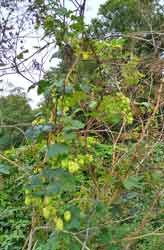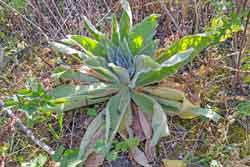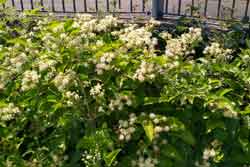Nature at Culham Station
Being situated close to open countryside, and with an abundance of undisturbed lineside habitats, the ticket office is fortunate in being surrounded by a wide and ever changing display of nauture. Red Kites are often seen circling overhead whistling to each other and sometimes being harassed by crows. Rabbits abound and badgers live in the bridge embankment, grey squirrels are often seen, and there has been the odd sighting of a stoat. Insects, butterflies and bees love to visit the wild flowers and those in our containers outside the office. Who knows what else might be happily living unseen in the inpenetrable undergrowth. Here we highlight some of the more unusual things that have caught our attention.
Oxford Ragwort
The opening of the Didcot to Oxford branch of the Great Western Railway did not only provide ease of movement for people and goods, but it also facilitated the spread of an invader.
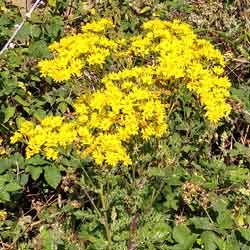
Oxford Ragwort growing behind Platform 2
At the very end of the 1690s a species of plant was brought over from Sicily and introduced into the Oxford Botanic Gardens. Over the years the plant became established and thrived to the extent that within 100 years it had 'escaped' and could be found growing on the city walls and in the masonry of colleges. This led to the plant being given the common name of 'Oxford Ragwort' as it is distinct from the larger native 'Common Ragwort'. The plant was first found on the slopes of Mount Etna and is a hybrid of two species Senecio aethnensis and Senecio chrysanthemifolius only found in Sicily, each growing at different altitudes. This yellow flowered plant, Senecio squalidus, is a member of the Daisy family and all parts of the plant are poisonous, with the sap burning bare skin. Its seeds float on air currents like the Dandelion so it was inevitable that they would slowly spread from their intended home.
Originally growing on the volcanic ash slopes of Mount Etna, the plant found an ideal home in the ballasted railway trackbed. Seeds would be swept along by the air currents from passing trains and they also got whisked far along the track after entering carriages and wagons. Eventually spreading throughout most of the UK rail network it can now also be found on building sites, roadsides, waste ground and wherever a suitable habitat can be found. Keep an eye out trackside any time between April and October and you should spot the escapee from Oxford.
Swift family
Right in one corner, under the overall roof above the disused platform, is a small hole where the boarding has warped. Just visible inside is a nest and during the summer we often see a bird flying in or out. At first we wondered what type of bird it could be - either a Swallow, House Martin or a Swift as they are all pretty similar at first sight.
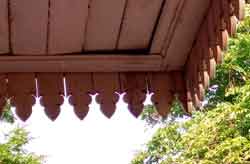
We have decided it is a Swift family who have chosen the Old Ticket Office as their summer home as they like to make their nest high up in holes in old buildings sheltered from the sun and rain. From there the birds are able to drop into the air from the nest entrance. This spot certainly fits the bill. Swallows and House Martins make their nests out of mud attached to the surface of a wall sheltered under the eaves.
Swifts migrate from southern and equatorial Africa and only spend a few months (April or May to August) with us in the UK. They are a true dweller of the air as they eat, preen, mate and can even sleep in the air, only nesting to raise their family. Pairing up for life, they would typically lay two or three eggs each season. As Swifts can live for up to 20 years and they return to the same nest each summer we hope to see our welcome lodgers for many years to come.
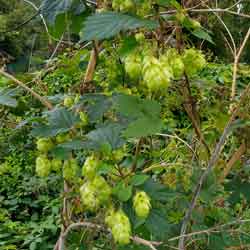
Hops
We were surprised to discover several Common Hop vines growing in the hedgerow down the road alongside platform 2. Its scientific name is Humulus Lupulus and, being a native plant, can apparently be found right across the country apart from some areas of Scotland. It flowers between July and September with green-yellow coloured male flowers growing in loose branching groups, whereas the female flowers are catkins, shaped like a cone. The male and female flowers grow on different plants and it is the female flower which develops into the fruit which is initially light green and turns to brown when it has ripened developing a distinctive scent.
It is well known that hops have been used in beer making since the Middle Ages but other parts from the plant had culinary and medicinal uses too and pillows filled with dried hops were said to encourage a sweet-scented restorative sleep.
We hope the gardeners employed by Network Rail to tidy the verges from time to time are not over zealous and clear these vines away, as Hop helps create dense habitat providing a small microclimate and valuable refuge for insects and nesting or roosting birds. The plant’s flowers also provide nectar for insects.
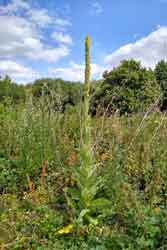
Mullien
This unusual plant is the Verbascum thapsus, commonly called 'Common Mullien' or 'Great Mullien' and is part of a wider family of similar plants. It is native to Britain and Europe, but has spread around the world, and can be found growing on waste ground, roadside verges and in gardens. Its hallmark characteristic is its tall stalk with a long spike of yellow flowers that are quite fragrant with each plant being capable of producing over 180,000 seeds. The plant is a biennial, spending its first year as a rosette of furry leaves, going on to produce its tall spike and flowers between June and August of its second year. When fully grown the spike can reach a height of 2 metres or more (up to 8 feet).
Mullein once enjoyed a magical reputation as a protector against witches and their spells, often being planted in gardens to ward off evil spirits and as protection from the devil. This is also regarded as being a medicinal herb with all parts of the plant being used except the seeds which are toxic. The leaves can be used for making tea which is said to good for easing many respiratory ailments. An infused oil made with the flowers can be used to treat ear infections, cuts and grazes.
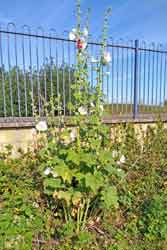
Hollyhocks
The Hollyhock or Alcea Rosea is an old cottage garden favourite that can easily be found all over the country, but is most common in the East and South. Escaping from its confines and naturalising in any crack and crevice of the urban landscape it grows on waste ground, refuse tips, and beside roads and railways, and is beneficial to wildlife such as bees and butterflies which visit to collect its nectar. Hollyhocks can reach heights of 6 feet or more depending on variety. Its textured foliage is fan-shaped and mid-green in colour with Its beautiful long spires holding a display of paper-like blooms from June or July until September or even later.
Whilst most people would think of the Hollyhock as being a native plant it is in fact originally native to China and central and south-western Asia. It is thought to have been introduced to Britain as early as 1290 by Eleanor of Castile, queen to Edward I. The Hollyhock is another medicinal herb with leaves, roots, flowers and seeds all being edible.
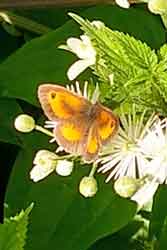
Gatekeeper butterfly
The gatekeeper, also known as the 'Hedge brown', is a medium-sized, brown butterfly that is on the wing in July and August. It is a butterfly of grassland, hedgerows and woodland edges and can be seen feeding on wild marjoram, bramble and ragwort, all of which abound at the station. The combination of bright orange wing patches, one large eyespot on the forewing and one smaller eyespot on the hindwing, is unique to the gatekeeper. The gatekeeper also has two small white 'pupils' in the eyespots, instead of one like the meadow brown. These details are not too clear on our thumbnail, but can be seen on the enlarged original. Its scientific name is Pyronia tithonus britanniae and this subspecies is commonly found all over the southern, warmer, parts of Britain.
Our photograph shows the male butterfly which can be identified by the brown wing stripes which are absent on the female. Try as we might, it proved impossible to catch a female long enough to photograph.
Wild Clematis
We believe this rather rampant plant is the native Clematis vitabla, otherwise known as 'Wild Clematis' or 'Old Man's Beard' which is in fact a member of the Buttercup family. This plant is very similar to, and easily confused with, another species introduced about a hundred years ago, Clematis flammula, which is native to southern Europe and north Africa. Our Clematis has been intoduced to other parts of the world where it is often now regarded as an invasive species, especially in New Zealand where it is declared an 'unwanted organism' and cannot be sold, propagated or distributed.
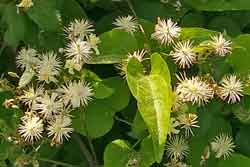
Wild Clematis is widespread across the warmer regions of Britain, being commonly found in southern and eastern England and parts of Wales although as temperatures rise it is spreading futher northwards. It is a climbing plant that entwines itself around other plants and bushes for support. Generally growing in poorer soil it produces masses of distinctive white flowers flowers in July and August, and during autumn and early winter carries masses of feathery fruit clusters which give rise to its popular name. The plant has seen some medicinal usees in the past, with tea made from its leaves believed to have restorative or stimulant properties which gave rise to it sometimes being called 'Traveller's Joy. It was also said to posess anti-inflamatory properies and was used as a poultice to treat blisters and other skin ailments. Other uses of the vine-like stems have been in basket making and for use as cordage.
Hummingbird hawk-moth
A visitor to the ticket office, who knows more about these things than we do, excitedly called us outside to see a very special moth enjoying the flowers in our flower troughs. She identified it as being a hummingbird hawk-moth, or macroglossum stellatarum. This small moth which has a wingspan of about 2" (50-55mm) is a summer visitor to the UK, with adults migrating from Southern Europe. Even though the moths can breed in the UK, they are not able to survive the winter. It prefers to fly in bright sunlight and when feeding darts from flower to flower then hovers, with its wings beating many times a second, to sip the nectar with its long proboscis, very much like a hummingbird.
We had never seen one of these visitors before and tried, but failed, to take a decent photograph. Luckily Jane Cockman managed to capture this fine image of one in her Cambridge garden in August, 2006.
Please note:
Where plants are identified as being edible or medicinal, this is intended for interest only and should not be interpreted otherwise.Knowledgeable advice should always be sought before consuming any foraged plants, fruit, nuts etc. as mistakes can be dangerous.



